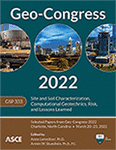Bioinspired Horizontal Self-Burrowing Robot
Publication: Geo-Congress 2022
ABSTRACT
Many organisms adopt well-evolved strategies and traits to facilitate burrowing/penetration in soils. Example features include the “dual-anchor” strategy used by razor clams and rotational drilling adopted by scarab beetle larva and some seed awns. Overall, underground burrowing requires overcoming resistances to advance forward and forming anchorage to prevent slip backward. Inspired by the aforementioned self-burrowing features, we designed a modular horizontal burrowing robot that features an extensible body and a rotatable tip. The robot was buried 7 cm below the surface of a bed of glass beads, and burrowed by cyclically alternating extension/retraction of the body segment, facilitated by the rotation of the tip. The burrowing performance of the designed robot was evaluated under different tip designs and control strategies. Insights into the general principles of burrowing in granular media were discussed by comparing to swimming in low Reynolds number fluids.
Get full access to this article
View all available purchase options and get full access to this chapter.
REFERENCES
Abdalla, A., Hettiaratchi, D., and Reece, A. (1969). “The mechanics of root growth in granular media.” Journal of Agricultural Engineering Research, 14(3), 236–248.
Bradski, G., and Kaehler, A. (2000). “OpenCV.” Dr. Dobb’s journal of software tools, 3.
Dorgan, K. M. (2015). “The biomechanics of burrowing and boring.” J Exp Biol, 218(Pt 2), 176–183.
Elbaum, R., Zaltzman, L., Burgert, I., and Fratzl, P. (2007). “The role of wheat awns in the seed dispersal unit.” Science, 316(5826), 884–886.
Guillard, F., Forterre, Y., and Pouliquen, O. (2014). “Lift forces in granular media.” Physics of Fluids, 26(4), 043301.
Hosoi, A. E., and Goldman, D. I. (2015). “Beneath Our Feet: Strategies for Locomotion in Granular Media.” Annual Review of Fluid Mechanics, Vol 47, S. H. Davis, and P. Moin, eds., Annual Reviews, Palo Alto, 431–453.
Huang, S., and Tao, J. (2021). “Force-chain evolution in granular packings under a razor-clam inspired penetration.” Bulletin of the American Physical Society.
Lucas, B. D., and Kanade, T. An iterative image registration technique with an application to stereo vision. Vancouver, British Columbia.
Maladen, R. D., Ding, Y., Li, C., and Goldman, D. I. (2009). “Undulatory swimming in sand: subsurface locomotion of the sandfish lizard.” science, 325(5938), 314–318.
Maladen, R. D., Ding, Y., Umbanhowar, P. B., and Goldman, D. I. (2011). “Undulatory swimming in sand: experimental and simulation studies of a robotic sandfish.” The International Journal of Robotics Research, 30(7), 793–805.
Maladen, R. D., Ding, Y., Umbanhowar, P. B., Kamor, A., and Goldman, D. I. (2011). “Mechanical models of sandfish locomotion reveal principles of high performance subsurface sand-swimming.” Journal of The Royal Society Interface, 8(62), 1332–1345.
Naclerio, N. D., Hubicki, C. M., Aydin, Y. O., Goldman, D. I., and Hawkes, E. W. “Soft robotic burrowing device with tip-extension and granular fluidization.” Proc., 2018 IEEE/RSJ International Conference on Intelligent Robots and Systems (IROS), IEEE, 5918–5923.
Ortiz, D., Gravish, N., and Tolley, M. T. (2019). “Soft Robot Actuation Strategies for Locomotion in Granular Substrates.” IEEE Robotics and Automation Letters, 4(3), 2630–2636.
Pitcher, C., and Gao, Y. (2015). “Analysis of drill head designs for dual-reciprocating drilling technique in planetary regoliths.” Advances in Space Research, 56(8), 1765–1776.
Purcell, E. M. (1977). “Life at low Reynolds number.” American journal of physics, 45(1), 3–11.
Sadeghi, A., Tonazzini, A., Popova, L., and Mazzolai, B. (2014). “A novel growing device inspired by plant root soil penetration behaviors.” PloS one, 9(2), e90139.
Sharpe, S. S., Koehler, S. A., Kuckuk, R. M., Serrano, M., Vela, P. A., Mendelson, J., and Goldman, D. I. (2015). “Locomotor benefits of being a slender and slick sand swimmer.” Journal of Experimental Biology, 218(3), 440–450.
Tang, Y., Huang, S., and Tao, J. “Effect of Rotation on Seeds’ Self-Burial Process: Insights from DEM Simulations.” Proc., Geo-Congress 2020: Biogeotechnics, American Society of Civil Engineers Reston, VA, 293–301.
Tang, Y., and Tao, J. (2021). “Effect of Rotation on Penetration: Toward a Seed Awn-Inspired Self-Burrowing Probe.” IFCEE 2021, 149–159.
Tao, J. J., Huang, S., and Tang, Y. (2019). “Bioinspired Self-Burrowing-Out Robot in Dry Sand.” Journal of Geotechnical and Geoenvironmental Engineering, 145(12), 02819002.
Tao, J. J., Huang, S., and Tang, Y. (2020). “SBOR: a minimalistic soft self-burrowing-out robot inspired by razor clams.” Bioinspiration & biomimetics, 15(5), 055003.
Trueman, E. (1967). “The dynamics of burrowing in Ensis (Bivalvia).” Proceedings of the Royal Society of London B: Biological Sciences, 166(1005), 459–476.
Winter, A., Deits, R., Dorsch, D., Slocum, A., and Hosoi, A. (2014). “Razor clam to RoboClam: burrowing drag reduction mechanisms and their robotic adaptation.” Bioinspiration & biomimetics, 9(3), 036009.
Information & Authors
Information
Published In
History
Published online: Mar 17, 2022
Authors
Metrics & Citations
Metrics
Citations
Download citation
If you have the appropriate software installed, you can download article citation data to the citation manager of your choice. Simply select your manager software from the list below and click Download.
